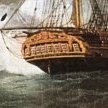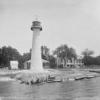-
Posts
2,156 -
Joined
-
Last visited
Reputation Activity
-
 JSGerson got a reaction from CaptainSteve in Rattlesnake by JSGerson - FINISHED - Mamoli - 1:64 - Using Robert Hunt’s practicum
JSGerson got a reaction from CaptainSteve in Rattlesnake by JSGerson - FINISHED - Mamoli - 1:64 - Using Robert Hunt’s practicum
Masts…Again
Meanwhile, back at the masts, all three lower masts were completed to this point:
-
 JSGerson got a reaction from CaptainSteve in Ship’s Boat by JSGerson - FINISHED - Model Shipways
JSGerson got a reaction from CaptainSteve in Ship’s Boat by JSGerson - FINISHED - Model Shipways
Model Shipways Typical Ship’s Boat* (SMALL)
*As labelled on the kit. On the website it’s called: Plank-on-Frame Lifeboat Kit
I am building the Mamoli 1:64 scale 1781 American Privateer Rattlesnake with the help of Robert Hunt’s Practicum. In the process of building the Rattlesnake, I had to make the ship’s boat. The Mamoli kit provided the model builder with a pre-cut wooden shell for the hull from which the builder could then create a completed model (which the Practicum addresses). If I had built the Model Shipways’ version of the Rattlesnake, I would have had to make the ship’s boat “bread and butter” style. Somehow neither option satisfied me. So I decided to go all out and build a ship’s boat from the keel up or as the case turn out, from the keel down.
Model Shipways makes 5 sizes of kits; I purchased the Typical Ship Boat No. MS0108, a Plank-on-Frame construction kit (POF).
Model No.: Size
MS0105 3-3/16'' (81mm) MS0106 3-3/4'' (95mm) MS0107 4-1/4'' (108mm) MS0108 4-3/4'' (122mm) MS0109 5-3/16'' (135mm)
This is my first POF as well as my first small boat build, so this will be all new territory for me. Not only that, I won’t have the Practicum to hold my hand until the hull is built.
The kit is fairly simple, one laser cut sheet provided the keel, the bow bulkhead, the transom, and the frames to create the bot’s ribs. A bunch of stock wood pieces which I believe to be Basswood as it is fairly soft was also included. The instructions are straight forward but not overly detailed so a lot of the skills and nuances of model building must be brought with the builder. Unfortunately the resolution of the photo images in the instructions is low and therefore hard to see detail.
-
 JSGerson got a reaction from fnkershner in Ship’s Boat by JSGerson - FINISHED - Model Shipways
JSGerson got a reaction from fnkershner in Ship’s Boat by JSGerson - FINISHED - Model Shipways
After the strips were dry, they were cut to their final size and glued into place.
-
 JSGerson got a reaction from Stevenleehills in The Kit-Basher's Guide To The Galaxy
JSGerson got a reaction from Stevenleehills in The Kit-Basher's Guide To The Galaxy
Small Cleats
When building my first wooden model in thirty years, the Evergreen I needed to tie lines to the deck. I was winging it because the kit didn't have any detailed plans for any of the rigging and I knew nothing about rigging. I needed tiny cleats. Somehow I got an idea to use the tiny rail nails used by railroad hobbyist. In cross section a nail is the shape of a T, very similar to a cleat - a very short T.
I filed the edges of the nail head as shown in the diagram below. This gets you the basic shape. You can file the ends to a more pointed shape and add an upward bend to either side. Just drill a hole and insert to the depth required.
-
 JSGerson got a reaction from JPett in Rattlesnake by JSGerson - FINISHED - Mamoli - 1:64 - Using Robert Hunt’s practicum
JSGerson got a reaction from JPett in Rattlesnake by JSGerson - FINISHED - Mamoli - 1:64 - Using Robert Hunt’s practicum
Using my newly constructed V-block jig, the spare mast was cut, carved, filed, and sanded to shape.
-
 JSGerson got a reaction from Mirabell61 in Rattlesnake by JSGerson - FINISHED - Mamoli - 1:64 - Using Robert Hunt’s practicum
JSGerson got a reaction from Mirabell61 in Rattlesnake by JSGerson - FINISHED - Mamoli - 1:64 - Using Robert Hunt’s practicum
The spares were then glued to the bits. In this photo they haven’t been lashed down yet.
-
 JSGerson got a reaction from Marcus.K. in The Kit-Basher's Guide To The Galaxy
JSGerson got a reaction from Marcus.K. in The Kit-Basher's Guide To The Galaxy
Small Cleats
When building my first wooden model in thirty years, the Evergreen I needed to tie lines to the deck. I was winging it because the kit didn't have any detailed plans for any of the rigging and I knew nothing about rigging. I needed tiny cleats. Somehow I got an idea to use the tiny rail nails used by railroad hobbyist. In cross section a nail is the shape of a T, very similar to a cleat - a very short T.
I filed the edges of the nail head as shown in the diagram below. This gets you the basic shape. You can file the ends to a more pointed shape and add an upward bend to either side. Just drill a hole and insert to the depth required.
-
 JSGerson got a reaction from CiscoH in The Kit-Basher's Guide To The Galaxy
JSGerson got a reaction from CiscoH in The Kit-Basher's Guide To The Galaxy
Small Cleats
When building my first wooden model in thirty years, the Evergreen I needed to tie lines to the deck. I was winging it because the kit didn't have any detailed plans for any of the rigging and I knew nothing about rigging. I needed tiny cleats. Somehow I got an idea to use the tiny rail nails used by railroad hobbyist. In cross section a nail is the shape of a T, very similar to a cleat - a very short T.
I filed the edges of the nail head as shown in the diagram below. This gets you the basic shape. You can file the ends to a more pointed shape and add an upward bend to either side. Just drill a hole and insert to the depth required.
-
 JSGerson got a reaction from Martin W in Rattlesnake by JSGerson - FINISHED - Mamoli - 1:64 - Using Robert Hunt’s practicum
JSGerson got a reaction from Martin W in Rattlesnake by JSGerson - FINISHED - Mamoli - 1:64 - Using Robert Hunt’s practicum
Scott - Welcome aboard the Rattlesnake Armada! It's nice to see another "Rattler." There are a number of us building this classic here as you know and probably many of the problems that you may encounter will already have been discussed at length on other builds be they Rattlesnake or others. There are no stupid questions. If you don't know or can't find the info, just ask. Enjoy your build.
-
 JSGerson got a reaction from JPett in Rattlesnake by JSGerson - FINISHED - Mamoli - 1:64 - Using Robert Hunt’s practicum
JSGerson got a reaction from JPett in Rattlesnake by JSGerson - FINISHED - Mamoli - 1:64 - Using Robert Hunt’s practicum
The spares were then glued to the bits. In this photo they haven’t been lashed down yet.
-
 JSGerson got a reaction from goatfarmer11 in Rattlesnake by JSGerson - FINISHED - Mamoli - 1:64 - Using Robert Hunt’s practicum
JSGerson got a reaction from goatfarmer11 in Rattlesnake by JSGerson - FINISHED - Mamoli - 1:64 - Using Robert Hunt’s practicum
I final finished my first wooden boat, the Mini Mamoli British Schooner Evergreen, a 1:125 Scale Solid Hull Model after a two year build. This was my first attempt at such an endeavor in 30 years. I had started the Billings Boat’s POB Zwarte Zee , an ocean tug back then but got about only about 85% complete. I never finished it. So with a completed build under my belt, I set my sights on the 1781 American Privateer, The Rattlesnake. I considered the Evergreen my “training wheels” for this build. Although technically the Zwarte Zee was my first POB boat, all of the planking flaws were covered up with wood filler and paint. This would be my first true test in this construction method. What you see is what I built for better or worse.
This build was started in October 2010 and I have only now decided in May 2013, to post my build log. I was reluctant to do so because compared to the others members who post comments regularly and have submitted their many build logs, I am but a beginner. I have knowing or unknowingly made many errors, omissions, and mistakes. It would be like hanging out my dirty laundry. But after some prodding by some of the members, I agreed to post my build if anything to show the error of my ways to anyone who wants to follow a slooow moving project.
I had a choice of the Mamoli or the Model Shipway kit. After a little research I discovered Robert Hunt’s Practicum (http://www.lauckstreetshipyard.com/) and thought this is just perfect for me. Having struggled through the minimal instructions of the Norwegian translation for the Zwarte Zee and the simplistic instructions translated from the Italian for the Evergreen, and after reading the free sample Chapter 1 with its highly detailed instructions and detailed photographs, I was easily convinced to purchase Robert’s practicum. There I found that the practicum was based on the Mamoli kit, so I chose that kit to build. To be fair, Mr. Hunt did state that his practicum could also be used for the Model Shipway kit. The practicum was written to both supplement and enhance the original kit instructions or to kitbash the project. Because the “journey” to me is the purpose of building a model, rather than the destination, the final model, I chose to build the kitbash and plunked down my money:
· Basic kit - ~$240
· Robert Hunt’s Practicum (http://www.lauckstreetshipyard.com/) - $150
· Harold Hahn’s plans ¼” scale - $45
· Reduce the Hahn plans 74% to match the kit’s 3/16” scale (1:64) - ~$25
· Hobbymill Wood Package (http://www.hobbymillusa.com/) - $210
This not a cheap build/modification. This does not include the tools that I accumulated and still am accumulating for this project. Hell, it’s a hobby, so it’s OK, that and the fact that I just retired and am a bachelor.
A kitbash goes beyond what the basic kit instructs to make the model more interesting, challenging, and pleasing. In this case Mr. Hunt’s practicum is based on the model Harold Hahn, a master model builder, built using plans he created based directly from the original British Admiralty drawings. Although this is an American ship, it was captured by the British and it is from them we can thank for having the historical drawings and the name Rattlesnake. In this model Mr. Hahn used direct woods to create the colors of the ship. Therefore in keeping true the Hahn model, the practicum substitutes the basic kit wood with a wood package purchased separately from Hobbymill (http://www.hobbymillusa.com/); and has you purchase the Harold Hahn copyrighted plans which Robert is basing his kitbashing modifications. Since Mr. Hahn built his model in ¼” scale, the plans have to reduce to match the kit scale of 3/16” (1:64). Your ordinary office copy won’t do the trick due to the size of the sheets. You need a large copier and one that can do reductions, specifically 74%, the kind found at a large stationary store, graphics, or engineering firm.
-
 JSGerson got a reaction from CiscoH in Rattlesnake by JSGerson - FINISHED - Mamoli - 1:64 - Using Robert Hunt’s practicum
JSGerson got a reaction from CiscoH in Rattlesnake by JSGerson - FINISHED - Mamoli - 1:64 - Using Robert Hunt’s practicum
At this point, according to the Practicum, the hull is complete. What is left in Chapter nine of the Practicum to complete is the ship’s boat and the spare masts it rests on; and maybe a tweak or two here and there. Here are a couple of parting shots.
Well, it not perfect. I would have been very surprised if it was but it will have to do.
-
 JSGerson got a reaction from wallyinstittsville in Rattlesnake by JSGerson - FINISHED - Mamoli - 1:64 - Using Robert Hunt’s practicum
JSGerson got a reaction from wallyinstittsville in Rattlesnake by JSGerson - FINISHED - Mamoli - 1:64 - Using Robert Hunt’s practicum
Pins were then added for added strength when attaching to the side of the hull
-
 JSGerson got a reaction from wallyinstittsville in Rattlesnake by JSGerson - FINISHED - Mamoli - 1:64 - Using Robert Hunt’s practicum
JSGerson got a reaction from wallyinstittsville in Rattlesnake by JSGerson - FINISHED - Mamoli - 1:64 - Using Robert Hunt’s practicum
Boarding Ladders
Surprisingly (or not) the Practicum also does not address the boarding ladder, those little steps on the outside of the hull. Mamoli does have an illustration as to how to construct them but I didn’t like the looks of it when I reviewed how other models made theirs. they were to be made with stacked upside down L-shaped channels. So to put it into technical terms, I winged it.
Based on the picture of the steps I “guestimated” their dimensions. The steps are not simply slabs of wood stuck to the side of the hull. They appear to be either two layers of wood, one smaller than the other, or one thick piece carved.
Because of the size of the step pieces, I chose to make each out of one piece of wood. I converted my rotary drill into a pseudo router again using a dentist sized ball burr tip as my cutter. A piece of 1/16” x 3/32” boxwood about 2” long was placed into my pseudo router to cut an inverted rounded corner along the whole length of wood strip. Then eight ¼” pieces were cut, four steps for each side of the model. The new two edges of each piece were then “routed” leaving the fourth side untouched.
-
 JSGerson got a reaction from MEDDO in Rattlesnake by JSGerson - FINISHED - Mamoli - 1:64 - Using Robert Hunt’s practicum
JSGerson got a reaction from MEDDO in Rattlesnake by JSGerson - FINISHED - Mamoli - 1:64 - Using Robert Hunt’s practicum
At this point, according to the Practicum, the hull is complete. What is left in Chapter nine of the Practicum to complete is the ship’s boat and the spare masts it rests on; and maybe a tweak or two here and there. Here are a couple of parting shots.
Well, it not perfect. I would have been very surprised if it was but it will have to do.
-
 JSGerson got a reaction from WackoWolf in Rattlesnake by JSGerson - FINISHED - Mamoli - 1:64 - Using Robert Hunt’s practicum
JSGerson got a reaction from WackoWolf in Rattlesnake by JSGerson - FINISHED - Mamoli - 1:64 - Using Robert Hunt’s practicum
Boarding Ladders
Surprisingly (or not) the Practicum also does not address the boarding ladder, those little steps on the outside of the hull. Mamoli does have an illustration as to how to construct them but I didn’t like the looks of it when I reviewed how other models made theirs. they were to be made with stacked upside down L-shaped channels. So to put it into technical terms, I winged it.
Based on the picture of the steps I “guestimated” their dimensions. The steps are not simply slabs of wood stuck to the side of the hull. They appear to be either two layers of wood, one smaller than the other, or one thick piece carved.
Because of the size of the step pieces, I chose to make each out of one piece of wood. I converted my rotary drill into a pseudo router again using a dentist sized ball burr tip as my cutter. A piece of 1/16” x 3/32” boxwood about 2” long was placed into my pseudo router to cut an inverted rounded corner along the whole length of wood strip. Then eight ¼” pieces were cut, four steps for each side of the model. The new two edges of each piece were then “routed” leaving the fourth side untouched.
-
 JSGerson got a reaction from WackoWolf in Rattlesnake by JSGerson - FINISHED - Mamoli - 1:64 - Using Robert Hunt’s practicum
JSGerson got a reaction from WackoWolf in Rattlesnake by JSGerson - FINISHED - Mamoli - 1:64 - Using Robert Hunt’s practicum
Miscellaneous Stuff
It was time to install three more items to the deck, two of which I had previous fabricated. First the tiller was added to the rudder post and the binnacle was glued to the deck. The third item, the “iron horse” was not addressed in the Practicum. This piece is nothing more than an upside down square shaped “U” wire structure behind the rudder post. Seemed simple enough, but because of the problems I encountered earlier with the transom and quarter deck, I had little room for its installation. My rudder post was practically against the transom. So being technically minded and handy with the tools, I fudged it, artistic license…so sue me. The kit called for brass wire, but that is very soft and therefore deforms very easily. I chose to use music (piano) wire. It’s dark in color and very stiff. My “horse” had to go above the rudder post for clearance due space considerations I mentioned earlier. As a result, mine looks a bit tall and narrow as opposed shorter which would make it look squatter.
-
 JSGerson got a reaction from AnobiumPunctatum in Rattlesnake by JSGerson - FINISHED - Mamoli - 1:64 - Using Robert Hunt’s practicum
JSGerson got a reaction from AnobiumPunctatum in Rattlesnake by JSGerson - FINISHED - Mamoli - 1:64 - Using Robert Hunt’s practicum
Final Assembly
-
 JSGerson got a reaction from goatfarmer11 in Rattlesnake by JSGerson - FINISHED - Mamoli - 1:64 - Using Robert Hunt’s practicum
JSGerson got a reaction from goatfarmer11 in Rattlesnake by JSGerson - FINISHED - Mamoli - 1:64 - Using Robert Hunt’s practicum
As anyone can see, this planking job leaves a bit to be desired, but there it is. If I were to do it again hopefully it would be better.
Tree Nails
The tree nails are lined up along the bulkheads, two treenails per width of the plank. At the butt joints the tree nails are staggered.
End of Chapter 4
-
 JSGerson got a reaction from Kenneth Powell in Rattlesnake by JSGerson - FINISHED - Mamoli - 1:64 - Using Robert Hunt’s practicum
JSGerson got a reaction from Kenneth Powell in Rattlesnake by JSGerson - FINISHED - Mamoli - 1:64 - Using Robert Hunt’s practicum
Pins were then added for added strength when attaching to the side of the hull
-
 JSGerson got a reaction from sport29652 in Rattlesnake by JSGerson - FINISHED - Mamoli - 1:64 - Using Robert Hunt’s practicum
JSGerson got a reaction from sport29652 in Rattlesnake by JSGerson - FINISHED - Mamoli - 1:64 - Using Robert Hunt’s practicum
The easy part is gluing them into place. Note two of the kevels are attached to aft rail post where the anchor is tied. The anchor had to be re-tied after the kevel was attached.
-
 JSGerson got a reaction from KenW in Rattlesnake by JSGerson - FINISHED - Mamoli - 1:64 - Using Robert Hunt’s practicum
JSGerson got a reaction from KenW in Rattlesnake by JSGerson - FINISHED - Mamoli - 1:64 - Using Robert Hunt’s practicum
Using a very fine chisel, the wood material between the lower horizontal cuts was carved to look like the side of a wheel when it will glued in place. Care must be taken here because even a slight slip may cause the chisel to slice through the tiny piece of wood between the cuts.
-
 JSGerson got a reaction from sport29652 in Rattlesnake by JSGerson - FINISHED - Mamoli - 1:64 - Using Robert Hunt’s practicum
JSGerson got a reaction from sport29652 in Rattlesnake by JSGerson - FINISHED - Mamoli - 1:64 - Using Robert Hunt’s practicum
Using a very fine chisel, the wood material between the lower horizontal cuts was carved to look like the side of a wheel when it will glued in place. Care must be taken here because even a slight slip may cause the chisel to slice through the tiny piece of wood between the cuts.
-
 JSGerson got a reaction from janos in Rattlesnake by JSGerson - FINISHED - Mamoli - 1:64 - Using Robert Hunt’s practicum
JSGerson got a reaction from janos in Rattlesnake by JSGerson - FINISHED - Mamoli - 1:64 - Using Robert Hunt’s practicum
Here is the model at this stage
-
 JSGerson got a reaction from janos in Rattlesnake by JSGerson - FINISHED - Mamoli - 1:64 - Using Robert Hunt’s practicum
JSGerson got a reaction from janos in Rattlesnake by JSGerson - FINISHED - Mamoli - 1:64 - Using Robert Hunt’s practicum
After the anchor rope passes through the deck rings it is fed into the main hatch. The Practicum instructed the builder to drill a hole through the grating with a 1/16” drill. The Mamoli plans show a square opening. Hahn’s plans are silent and his model is constructed in such a way that there are no gratings. The MS plan is ambiguous. The rope resolved the quandary. As soon as the rope is cut, it begins to unravel. Trying to keep it under 1/16” was impossible so I increased the hatch opening by cutting and making four grating opens into one. Now the rope had plenty of room to move during dropping and weighing anchor.
















